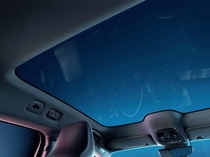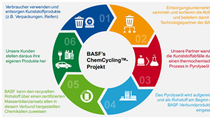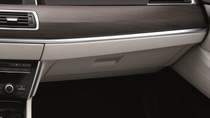Automotive
Sustainable ride in your living room on four wheels
BASF and Grupo Antolin have developed a headliner that is based on BASFs ChemCyclingTM process. Chemical recycling is an important addition to mechanical recycling and contributes to building a comprehensive circular economy.
The lightweight roof frame made with Ultradur® High Speed is based on ChemCyclingTM plastics from BASF.
Entertainment systems, massage seats, autonomous driving – the transformation of the car into a living room on wheels is well underway. The trend has long arrived in the ceiling trim as well. In 2018, one in three cars was already equipped with a glass roof. Particularly, the generous panorama variation fills the interior with a lasting feeling of light and lightness. Hence, the market for panoramic roofs is booming: an average annual increase in sales of 14 percent is expected until 2027. So, it's all sunshine and roses regarding headliners? Not quite. Traditionally, the glass panels are set into a heavy steel frame. Its weight contradicts the trend toward lightweight construction and, thus, the central objective of our time: reducing emissions for a climate-neutral future.
This induced BASF and Grupo Antolin to become creative. The result, a roof frame made of the glass fiber-reinforced polybutylene terephthalate (PBT) Ultradur® High Speed, reduces weight up to 60%. The plastic component is the first application in an automobile based on ChemCycling™ plastics from BASF that is ready for serial production.
Globally, about 250 million tons (EU: 30 million tons) of plastic waste is generated each year, but only about 20% (EU: about 30%) are mechanically recycled and kept in the material cycle. BASF’s ChemCycling™ approach is an innovative technology that can make a valuable contribution to building a comprehensive circular economy for plastics in the future. During the chemical recycling process, BASF's cooperation partners extract so-called pyrolysis oil from plastic waste using pyrolysis technology. The pyrolysis oil is fed into BASF's chemical production value chain instead of fossil raw materials.
ChemCycling™ exclusively uses plastic waste that cannot be mechanically recycled for technological and ecological reasons. Since it would otherwise be incinerated releasing emissions, chemical recycling forms an important addition to mechanical recycling which allows to conserve resources.
This way, high-quality products can be manufactured that are in no way inferior to products made from fossil raw materials and have a better carbon footprint. Both the manufacturing process and the proportion of recycled raw material in the product are certified by independent auditors.

In combination with BASFs noise-absorbing Elastoflex®, the headliner contributes to a pleasant driving experience.
"Ultradur® High Speed's excellent flowability makes it ideal for the production of large and thin trim parts for car interiors. In the case of the roof frame, this allows us to significantly reduce weight without losing stiffness and dimensional stability at high temperatures", added Prinz. After all, the roof frame plays an important role in the rigidity and, thus, the safety of the car.
In the same vehicle, BASF’s Elastoflex® E 3943/134 is used for the interior roof lining. The thermo foamable foam ensures pleasant driving comfort thanks to its excellent noise absorption. Due to its low density, it contributes to reducing the overall weight and minimizing CO2 emissions not only during the use phase but, as a ChemCycling™ product, already during manufacture.
Finally, an innovative and sustainable process is used to attach the Ultradur® frame to the interior roof lining as at the same time the Elastoflex® is foamed in the mold. This saves additional production steps and generates fewer overall emissions.
Through the ChemCycling™ approach, BASF and Grupo Antolin are successfully meeting the challenges of the present. Thus, feeling at home on your own four wheels will also be possible in the future.
Find out more about ChemCyclingTM and our versatile products:



